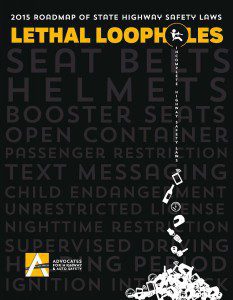 The Advocates for Highway and Auto Safety has released its 12th annual Roadmap of State Highway Safety Laws analyzing all of the state’s highway safety laws with a focus on what deficiencies exist in state laws. The report stresses that by closing these “lethal loopholes” and enacting better laws, needless deaths and injuries will be prevented. The report looks at laws pertinent to the following:
The Advocates for Highway and Auto Safety has released its 12th annual Roadmap of State Highway Safety Laws analyzing all of the state’s highway safety laws with a focus on what deficiencies exist in state laws. The report stresses that by closing these “lethal loopholes” and enacting better laws, needless deaths and injuries will be prevented. The report looks at laws pertinent to the following:
Occupant protection – Does the state require both front and rear passengers to wear seat belts and make failure to do so a primary offense? Are motorcyclists required to wear helmets?
Child passenger safety – Does the state require that children aged 4 through 7 be placed in a booster seat?
Teen drivers and GDL laws – How many of the recommended 7 laws that have been proven to save teen lives has each state enacted, including, minimum age for permit- 16, minimum age for unrestricted license- 18, restrictions on number of passengers, and at least 30 hours of supervised driving.
Drunk driving – Does the state require ignition interlock devices for convicted drunk drivers? Does the law either create a separate offense or enhance an existing penalty for an impaired driving offender who endangers a minor? Does the law prohibit open containers of alcohol in the automobile to include the passenger area and apply to all occupants of the motor vehicle (with some exceptions, e.g. taxis, limousines, etc)?
Distracted driving – Does the state prohibit all drivers from sending, receiving, or reading a text message from any handheld or electronic data communication device, except in the case of an emergency?
The Report is very comprehensive and makes it easy to compare state laws and identify what laws a state has enacted and what additional laws recommended by the Advocates have not been enacted. This is the Advocates’ Report and their analysis is based on enacting their “optimal laws”. If states did enact laws but did not include the “optimum criteria”, they would not receive credit for their laws. In order to fully compare states, one must look at the detailed grading system employed. I anticipate that some states will take exception to the scoring or the results. But it is an excellent starting place for all who want to improve highway safety and save lives.
In summary, only 10 states received the highest rating, “significantly advanced toward adoption of all Advocates’ recommended highway safety laws” – Maine, Rhode Island, Delaware, Louisiana, Indiana, Illinois, California, Oregon, Washington, Hawaii. Nine states received the lowest rating, “State falls dangerously behind in adoption of key safety laws” – Florida, Mississippi, Iowa, Nebraska, South Dakota, North Dakota, Wyoming, Montana and Arizona. All other states were “advancing” but with numerous gaps still in their highway safety laws”. The vast majority of states receiving the poorest ratings lacked a primarily enforced texting ban for all drivers, and several of those states issue licenses before age 16, or unrestricted licenses before age 18.




